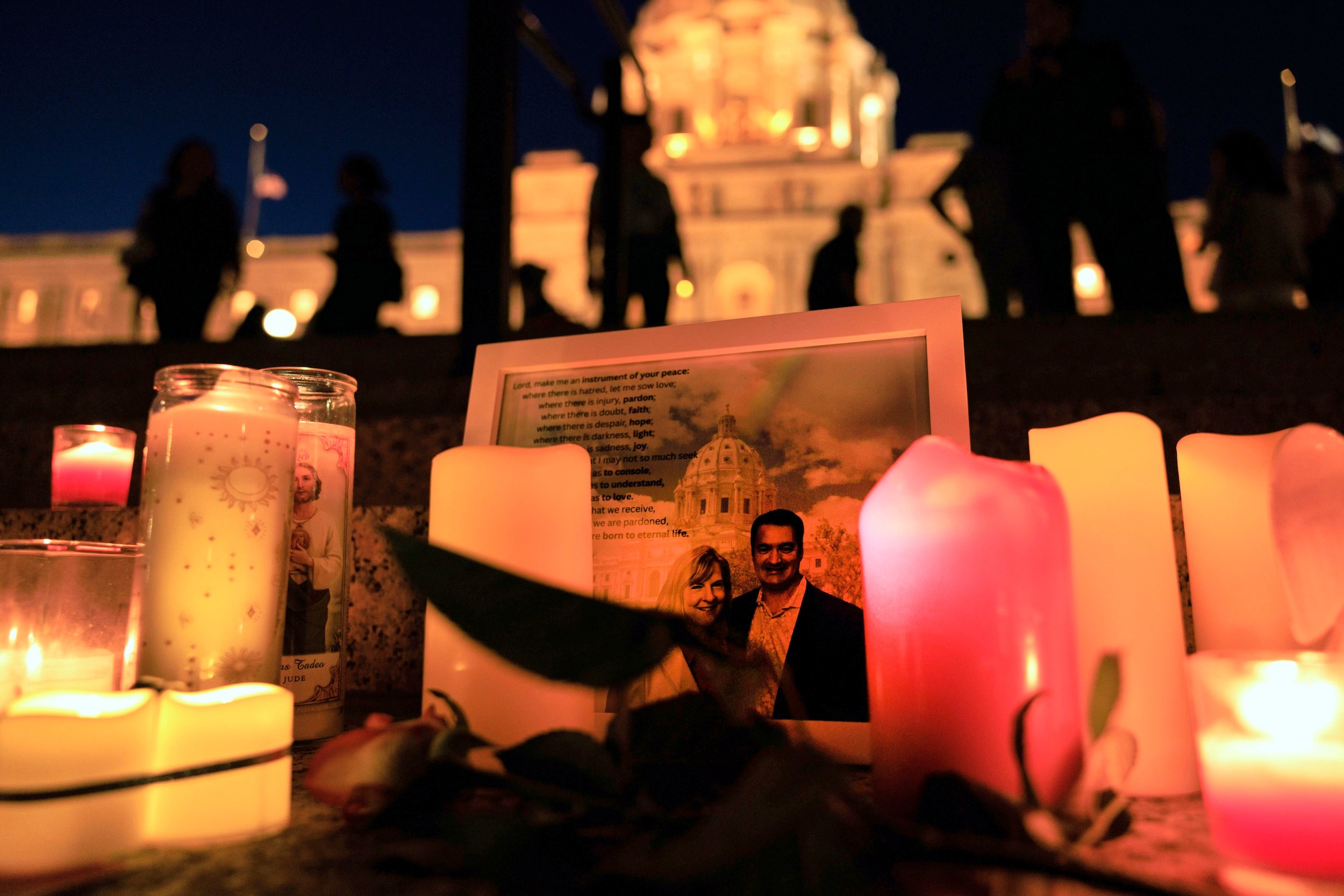It is not unusual to encounter hoaxes in the wake of tragedies, and in this era of America — in which tragedies like natural disasters and public acts of violence occur with enough regularity to overtake one another in the news cycle — they seem to appear at every turn, no matter how horrific the event or how heinous the rhetoric may look in hindsight. Just this past week, U.S. Representative Marjorie Taylor Greene, a Republican from Georgia, promulgated the baseless claim that the floods that took more than 100 lives, including children at summer camp, in the Texas Hill Country were brought about by “weather modification and geoengineering.”
For people in power, conspiracy can be useful in the wake of disaster — to avoid blame for policies that may have played a role in the tragedy, to raise their profile in national media, to raise money. Or, as The Trace’s Jennifer Mascia reports this week, to scapegoat.
After two Minnesota state lawmakers and their spouses were shot in their homes on June 14, social media was rife with false claims that the shooter was transgender. In fact, the suspect is a cisgender white man, reportedly a Trump supporter. The misinformation was part of a larger trend that began in earnest a few years ago: Baseless claims against trans people have become increasingly common in the immediate aftermath of public mass shootings. In her story, Mascia breaks down the data on trans people and mass shootings, and speaks with activists and experts about the conspiracy’s role in a broader right-wing effort to demonize trans people.
From The Trace
Why Does the Right Falsely Blame Trans People for Mass Shootings?: Misinformation circulating after last month’s attack on Minnesota state lawmakers underscores a calculated campaign to demonize the trans community.
Chicago’s July Fourth Weekend Shootings Plummeted. Residents Are Cautiously Optimistic: City officials and organizers say community violence intervention efforts are making Chicago safer, but they’re worried about funding cuts.
After Months of Declining Gun Violence, Shootings Surge in Philadelphia: So far, 57 people have been shot this July. Residents fear that the city’s progress on gun violence may be over.
Major Gun Violence Research Hub Escapes Crippling Funding Cuts: New Jersey lawmakers pushed back against the governor’s plan to slash the state research center’s budget, providing stability to the field amid shaky federal support.
An Unfinished Memorial, Looser Gun Laws: This Is Charleston 10 Years After the AME Church Shooting: “I can’t believe people have such a short attention span,” said one resident following the anniversary of one of America’s most deadly racist mass shootings.
These Detroit Activists Help People Turn Themselves In for Gun Crimes: An unconventional “safe surrender” program is changing how police pursue shooting suspects.
What We’re Reading
What is the ‘Seven Mountains Mandate’ and how is it linked to political extremism in the U.S.?: An expert on extremism gives a brief overview of the history and core beliefs of the Seven Mountains Mandate, which calls on Christians to gain influence over key areas of culture. [The Conversation]
Death in the Air: In her new book Murderland, Caroline Fraser traces the correlations between rapacious industrial pollution and sadistic serial killers. [The New York Review of Books]
American Gun Violence Goes Global: Gun violence has become a staple of daily life in the United States. Its spread outside of America’s borders may be diminishing the country’s soft power. [Foreign Affairs]
How Much Worse Is This Going to Get?: Ending any cycle of political violence requires a strong collective rejection — including the imposition of a political and social cost for those who would choose or cheer on violence to get their way. [The Atlantic]
Nearly Half of America’s Murderers Get Away With It: Most crimes go unsolved, emboldening criminals and potentially leading to more violence. [The New York Times]
In Memoriam
Daydrian Raymond Brown, 15, was a rising soccer star. He’d been playing since he was 5 years old, and his dedication to the sport — his strong work ethic and passion for the game — had landed him on an elite team in his hometown of Tuscon, Arizona, and the state’s Olympic Development Program. Daydrian was shot and killed last weekend, just doing what teenagers do: He told his mom a little white lie and went to a party. It ended with his shooting. He was a bright light, loved ones said. “He walks on the field with a smile on his face and changes your mood,” one of his soccer coaches told a local news station. Daydrian liked making silly voices and the color green. He was a good person, his mom told the Arizona Daily Star. “He made everyone around him feel loved,” she said. If there was a kid in the corner no one was talking to, he’s going to talk to that person.”
Spotlight on Solutions
While medical schools routinely teach students how to treat the aftermath of gunshot injuries, they rarely address how to talk with patients about avoiding them in the first place. Scrubs Addressing the Firearm Epidemic — an organization working to reframe gun violence as a preventable public health crisis that doctors are uniquely positioned to address — has an ambitious plan to change that. In the latest edition of The Trajectory newsletter, journalist Cat Carroll explains the gaps in medical education on gun violence prevention and how SAFE’S training initiative could change the game.
Pull Quote
“When it’s really hot, people’s fuses are short and they’re much more likely to react violently to very small slights.”
— Northeastern University criminologist James Alan Fox, on the association between heat and violent crime, to The Trace
